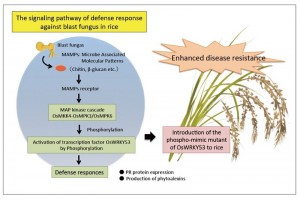Enhanced disease resistance in rice plants Phosphomimic Mutated OsWRKY53 transcription factor used

The research group of Associate Professor Kazunori Okada and former Professor Hisakazu Yamane at the Biotechnology Research Center, the University of Tokyo has shown that the phosphorylation of transcription factor OsWRKY53, which is expressed in rice response to infection with the rice blast fungus Magnaporthe oryzae, has an important role in rice plants’ gene expression in disease resistance. The research group had previously reported that overexpression of OsWRKY53 increased disease resistance in rice, but the mechanism by which it did so in response to infection with rice blast fungus remained unknown. In addition, while the importance of signaling via protein phosphorylation in gene expression associated with disease resistance is well known, the mechanism connecting the phosphorylation of OsWRKY53 and its role in disease resistance in rice remained unclear.

© 2014 Kazunori Okada.
The signaling pathway of defense response against blast fungus in rice. The OsMKK4-OsMPK3/OsMPK6 cascade regulates transactivation activity of OsWRKY53, and overexpression of the phospho-mimic mutant of OsWRKY53 leads to activation of a defense response against the blast fungus in rice plants.
Now, the research group has revealed that a phosphorylation-signaling MAP kinase of the rice plant OsMKK4-OsMPK3/6 phosphorylates OsWRKY53 to activate its functionality as a transcription factor, suggesting that this phosphorylation promotes the transcription of genes associated with plant resistance. The N-terminus of OsWRKY53 that is phosphorylated, and the research group showed that by replacing the N-terminus serine base with aspartate it was possible to create what was effectively an artificially-phosphorylated OsWRKY53. This “phospho-mimic” OsWRKY53 was found to function as a transcription factor in the same way as normally-phosphorylated OsWRKY53 and also strengthened the response of rice plants to infection.
The present research suggests that it should be possible to develop new techniques for creating disease-resistant strains of rice using transcription factors.
Press release (Japanese)
Paper
Tetsuya Chujo, Koji Miyamoto, Satoshi Ogawa, Yuka Masuda, Takafumi Shimizu, Mitsuko Kishi-Kaboshi, Akira Takahashi, Yoko Nishizawa, Eiichi Minami, Hideaki Nojiri, Hisakazu Yamane, Kazunori Okada,
“Overexpression of Phosphomimic Mutated OsWRKY53 Leads to Enhanced Blast Resistance in Rice”,
PLOS ONE Online Edition: 2014/6/3, doi:10.1371/journal.pone.0098737.
Article link (Publication,
UTokyo Repository)
Links
Biotechnology Research Center (Japanese)
Laboratory of Environmental Biochemistry, Biotechnology Research Center







